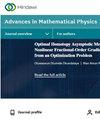Computational Fluid Dynamics for Cavity Natural Heat Convection: Numerical Analysis and Optimization in Greenhouse Application
IF 1.1
4区 物理与天体物理
Q3 PHYSICS, MATHEMATICAL
引用次数: 0
Abstract
Natural convection in cavity plays a significant role in energy-related field, including the indoor heat transfer analysis in greenhouse with integrated PV roof. In this study, mathematical model is established for two-dimensional heat transfer analysis in greenhouse air cavity, with numerical simulation through computational fluid dynamics (CFD). Main natural convection impact factors, such as system configuration parameters (tilting angle and PV panel unit number) and fluid thermal–physical properties, are investigated with indoor temperature distribution and streamline comparison by finite-volume method (FVD). Preliminary results show that with rising Rayleigh number (Ra), natural convection is enhanced with growing Nusselt number (Nu). Moreover, panel slope tilting angle (θ) highly determines inside heat transfer subregions in terms of the vertical temperature gradient declines with rising θ, improving the temperature distribution uniformity inside. The solar greenhouse example illustrates that with the increasing numbers of panel group numbers (n), the air temperature gradient differences decrease, improving the temperature distribution uniformity inside, which is preferable to built environment accurate control for greenhouse in the practical engineering. This work can provide modeling method support and reference for natural heat convection applications.空腔自然热对流的计算流体动力学:温室应用中的数值分析与优化
空腔中的自然对流在能源相关领域发挥着重要作用,包括集成光伏屋顶的温室的室内传热分析。本研究建立了温室空腔二维传热分析的数学模型,并通过计算流体动力学(CFD)进行了数值模拟。通过有限体积法(FVD)研究了主要自然对流影响因素,如系统配置参数(倾斜角和光伏板单元数)和流体热物理性质,并对室内温度分布和流线进行了比较。初步结果表明,随着雷利数(Ra)的增加,自然对流会随着努塞尔特数(Nu)的增加而增强。此外,面板斜面倾角(θ)在很大程度上决定了内部传热子区域的垂直温度梯度,随着θ的增大,垂直温度梯度逐渐减小,从而改善了内部温度分布的均匀性。日光温室实例表明,随着面板组数(n)的增加,空气温度梯度差减小,改善了内部温度分布的均匀性,这对实际工程中温室的建筑环境精确控制是有利的。这项工作可为自然热对流应用提供建模方法支持和参考。
本文章由计算机程序翻译,如有差异,请以英文原文为准。
求助全文
约1分钟内获得全文
求助全文
来源期刊

Advances in Mathematical Physics
数学-应用数学
CiteScore
2.40
自引率
8.30%
发文量
151
审稿时长
>12 weeks
期刊介绍:
Advances in Mathematical Physics publishes papers that seek to understand mathematical basis of physical phenomena, and solve problems in physics via mathematical approaches. The journal welcomes submissions from mathematical physicists, theoretical physicists, and mathematicians alike.
As well as original research, Advances in Mathematical Physics also publishes focused review articles that examine the state of the art, identify emerging trends, and suggest future directions for developing fields.
 求助内容:
求助内容: 应助结果提醒方式:
应助结果提醒方式:


